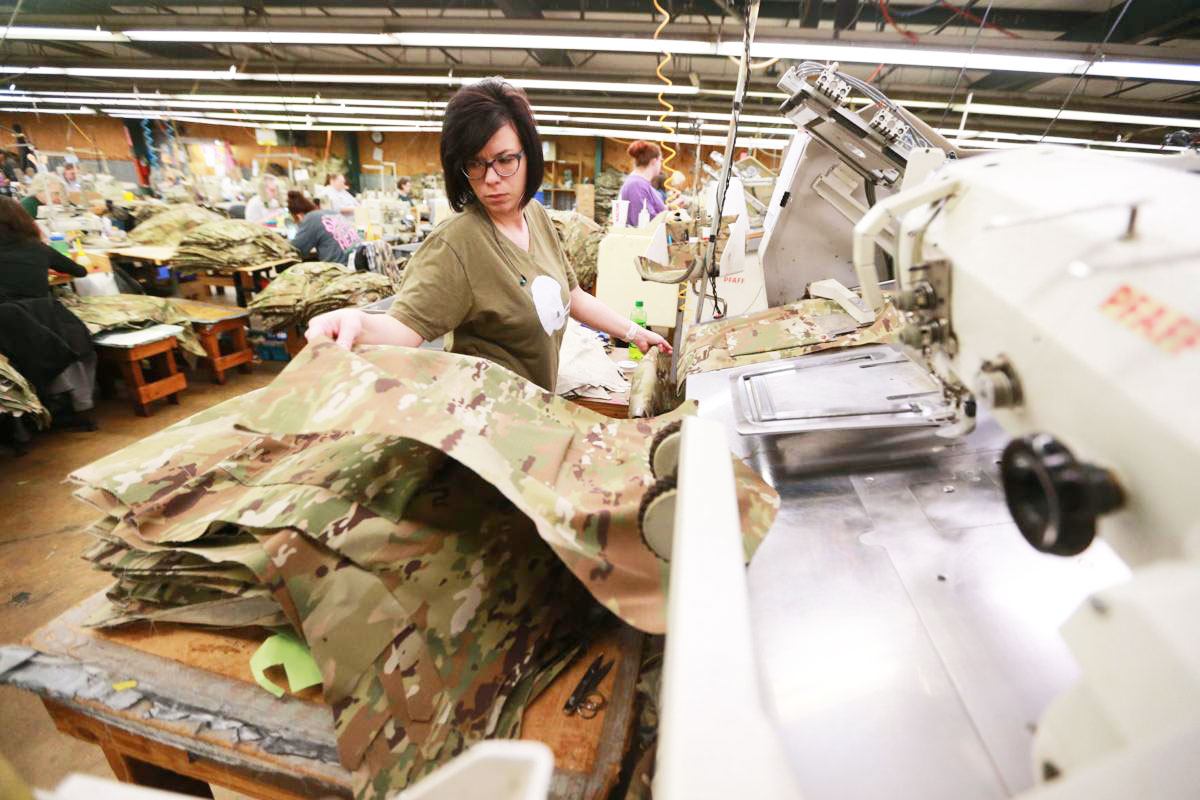One of if not the largest employers of seamsters in Mississippi is in this tiny Tishomingo County town, where manufacturing is the backbone of the economy.
Some 250 employees at Golden Manufacturing – mostly women – are steadily sewing, stitching, trimming and inspecting thousands of uniforms for the U.S. Military.
While Golden has been officially providing jackets and pants to the U.S. Army, Air Force and Navy since the late 1970s, the company it acquired had been doing it since the 1950s.
Company president and plant manager James Fennell, who’s also a partner in the operation, is overseeing the latest job – a contract for the Army.
Made for the military
“We’re finishing up a Navy coat – which is a shirt – and we’re working on a coat for the Army and the Air Force,” he said. “There’s an FR – which stands for flame-retardant – version as well as a regular OCP (occupational camouflage pattern) shirt that we’re producing.”
The flame-retardant shirts are worn mostly overseas by military personnel, as they help protect against potential IED blasts, Fennell said.
“We’ve been making military clothing and many, many types over the years,” he said, adding that the company has made some commercial clothing during that time.
But the bulk of the work – about 95 percent – is contracted to the U.S. military, which regularly asks for bids for clothing for each of its branches. Most of the work through the years at Golden has been done for the Army.
Companies from across the country compete to provide the clothing for the soldiers, sailors, marines and airmen on a contractual basis. The contracts often have options on them in which additional work can be doled out. What started as one-year contracts went to five-year contracts but have recently gone to two-year contracts, Fennell said.
“We’re always looking for bids of course,” he said. “They’ve gone back to the shorter bids because things change so quickly, and they can control their needs better.”
The winning bidders provide the military the clothing for a set price. Fabric is shipped to companies like Golden, who use state-of-the-art equipment to cut the patterns needed for shirts, jackets, pants, etc. It wasn’t long ago the patterns were cut by hand, but automation provides better efficiency, plus reduces waste.
Apparel makers based in the U.S. must compete against overseas companies that pay workers at a much lower rate, and any efficiency gained is a plus.
And Golden has been successful at landing contracts. While it isn’t the largest company making uniforms for the military, it has landed contracts worth up to $440 million since 2007.
There’s plenty of work for Golden and others to clothe the nearly 1.3 million active service members in the military, along with another 800,000 or so. Apparel wears out for them just as it does for anybody else.
“We’re making about 500,000 shirts a year,” Fennell said. Included is some work being sub-contracted from other companies who aren’t able to meet their contractual obligations and look to Golden for help. “The military goes through millions of pieces of clothing a year.”
Inspectors at various points in the process go over every stitch and seam of an item of clothing. Many items are shipped out to get coated by the fire-retardant spray, and are inspected again.
Yellow tape is used to indicate minor issues on an item of clothing, but a piece of red tape mean a serious flaw has been found and must be corrected or tossed.
“If we have to send it back, it usually doesn’t happen again,” Fennell said.
The U.S. military has exact standards to follow, and the tiniest of flaws means a possible rejection – and loss of money from the contract.
“We want as few of those as possible,” Fennell said.
Military uniforms are procured through the Defense Logistics Agency, an agency of the Department of Defense.
DLA Troop Support is responsible for getting nearly all of the food, clothing and medical supplies used by the military, including about 90 percent of the construction material used by troops in the field, and repair parts for aircraft, combat vehicles, and other weapons system platforms. According to DLA Troop Support’s website, “Each year, DLA Troop Support supplies and manages over $13.4 billion worth of food, clothing and textiles, pharmaceuticals, medical supplies and construction and equipment supplies in support of America’s warfighters worldwide and their eligible dependents.”
Within DLA Troop Support, the Clothing and Textile Directorate supplies more than 8,000 different items ranging from uniforms to footwear and equipment. According to DLA Troop Support, C&T sales of clothing, textiles, and equipment to military personnel worldwide is nearly $2 billion annually.













